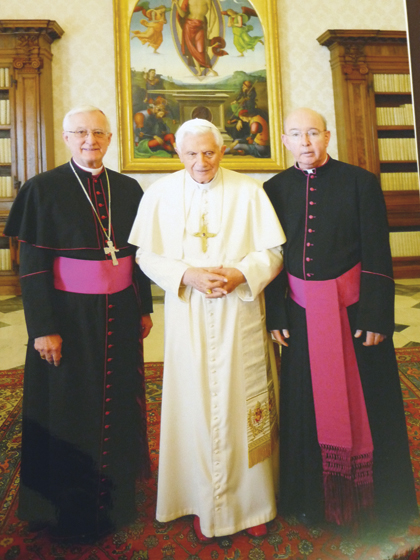By Barb Arland-Fye

Pope Benedict XVI appeared tired to Bishop Martin Amos and Vicar General Msgr. John Hyland when they posed for pictures with him during their visit to the Vatican earlier this month. But they were amazed at the demanding schedule the pontiff, who turns 85 next month, still keeps. Following back-to-back meetings with bishops from dioceses throughout the United States, the pope was to begin a trip to Cuba and Mexico this week.
Bishop Amos and Msgr. Hyland returned home to the Davenport Diocese with greater appreciation for the universal Church, felt privileged to meet with the Holy Father and to celebrate Mass in the most important basilicas in Rome. They also enjoyed staying in the “Domus Sanctae Marthae” (Latin for Saint Martha’s House) where the world’s cardinals reside when they elect a pope.
Bishops who lead dioceses are required to make an “ad limina” visit every five years. The Latin phrase’s formal title, “ad limina apostolorum,” means “to the thresholds of the apostles” Peter and Paul, who were martyred in Rome. The visit includes meetings with the Holy Father and Vatican officials.
“It was a totally new experience. I had never before had contact with the different offices and dicasteries (congregations or pontifical councils). Their vantage point is the universal Church,” Bishop Amos said, noting that the officials listened carefully to what he and his fellow bishops had to say. Bishops make their ad limina visits by region; the Davenport Diocese belongs to Region IX, which covers Missouri, Iowa, Nebraska and Kansas.
Among the topics discussed were procedures for merging or closing parishes; selection of bishops; unity among bishops; priests living longer lives and some being able to serve beyond age 80; politics and the Church; deacons being at the service of their bishops; the apostolic visitation of communities of women religious (the final report is expected to be positive); and the impact of pornography on families.
During a meeting with the Congregation for Catholic Education, Bishop Amos was pleased to hear an official mention St. Ambrose University in Davenport, noting that the university was doing very well.
At the Pontifical Council for the Laity, Bishop Amos had the opportunity to give a talk, saying:
“We as ordained realize it is our ministry to teach, to sanctify and to lead. We realize lay people are not there to serve us, but rather for us to serve them. At the same time, we realize that as ordained there is an essential difference between us and the lay state. Sometimes that can lead to tension. The ordained can, at times, be too clerical. At times, the lay people want to usurp our role and blur the distinction. For the most part, the laity loves their priests and the priests work well to minister to the laity.”
Many of the most devoted Catholics are involved in sharing their gifts and talents with the local Church and with parishes, he said. “Our bishops’ conference published a document titled “Co-workers in the Vineyard of the Lord,” which was careful to draw the distinction between ordained and lay. It welcomed the laity as co-workers, some of whom are highly trained and certified, who bring special gifts in teaching, finance and business. They fill our diocesan offices, staff schools, minister in hospitals and prisons and serve as catechists. They assist us in the liturgical life of our parishes. They are truly co-workers,” the bishop observed. “One of the challenges is to evangelize those who do not believe and to catechize those who do not know their faith, to help them grow in faith so that it permeates their lives and to help them witness to their faith so as to permeate our culture.”
During the Iowa bishops’ meeting with Pope Benedict XVI, each bishop addressed a specific topic; Bishop Amos spoke about the clergy sexual abuse crisis and how it has impacted the Catholic Church at the diocesan level. He also noted that the people still love their priests and their parishes and are committed to being Catholic.
As do all bishops making ad limina visits, the Region IX bishops concelebrated Mass at Rome’s four major basilicas: St. John Lateran, St. Peter’s, St. Paul Outside the Walls and St. Mary Major for the spiritual centerpiece of their pilgrimage.
“Being able to go to St. Peter’s and the other basilicas to offer Mass was probably the highlight of the trip for me,” said Msgr. Hyland, who last visited Rome in 2000.
Bishops, seminarian, Regina students meet in Rome
During their ad limina visit earlier this month, Bishop Martin Amos and Vicar General Msgr. John Hyland met up with Bishop Robert Gruss of the Diocese of Rapid City, S.D., whose first ad limina visit intersected with theirs. Bishop Gruss was a priest of the Davenport Diocese before being ordained a bishop last July. Bishop Amos and Msgr. Hyland also visited with Deacon Corey Close, a seminarian with the Davenport Diocese who is studying at the Pontifical North American College in Rome and will be ordained to the priesthood in June in Davenport. The bishop and vicar general also posed for pictures with students from Regina High School in Iowa City visiting Rome. Father Thom Hennen, vocations director for the Davenport Diocese, was among the chaperones.








